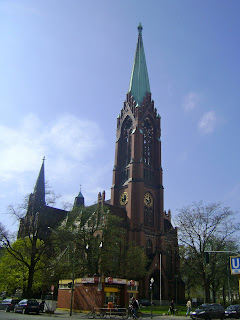Some historical facts about Schöneberg:
- The village was first documented in 1264
- During the Seven Years' War on 7 October 1760 Schöneberg and its village church were completely destroyed by a fire due to the joint attack on Berlin by Habsburg and Russian troops
- The following well-known people lived in Schöneberg at some point in their life: Albert Einstein, Marlene Dietrich, Christopher Isherwood, and David Bowie(!)
We began our excursion at the famous KaDeWe (or Kaufhaus des Westens / Department Store of the West), the second largest department store in all of Europe. It served as a symbol of western prosperity during the Cold War. One can find anything and everything here, including American commodities, such as Pop-Tarts, Dr. Pepper, and Jif Peanut Butter (all outrageously priced, however, e.g.: 18 euro for a container of Jif Peanut Butter). It also has an impressive alcohol selection, as seen by its stock of a brand of Cognac that sells for over 17,000 euro. Although I did not purchase anything today, I have consumed a scrumptious slice of cake from one of their bakers a month or so ago.
Afterward, our instructor, and tour guide for the morning, led us to another part of Schöneberg (Nollendorfplatz) that has been a center of gay life in Berlin since the 1920s. There is actually a plaque that commemorates all homosexuals that suffered at the hands of the Nazis outside the Nollendorfplatz U-Bahn Station:
And there is also a plaque that commemorates Christopher Isherwood, a famous homosexual English-American novelist that lived in Schöneberg from 1929-1933, which can be found on the wall of the building where he used to live:
We continued our journey on Goltzstraße, where we tasted wine at our instructor's "most beloved" Weinhandlung (wine shop), sampled apples at an Apfelgalerie, and bought chocolate from a chocolatier shop. The owner of the Weinhandlung was a generous lady who offered us ,2l of Riesling, a wine that originated in the Rhine of Germany (where I had the pleasure of first trying it in summer 2008). Apparently, and this was news to me, Riesling is a German specialty because the Riesling vines do not require a lot of sunlight, and since Germany lacks sunlight for the majority of the year, it serves as a perfect environment for the vines to grow. Second, the Apfelgalerie had an assortment of different types of fresh apples (for cheap!), home-made jams and marmalade, and dried fruit chips (mainly banana and apple). And last, the chocolatier was also a very nice woman. She had a variety of chocolates, including Easter specialities, and it was hard for me not to buy everything in sight. And people claim that Berliners have the same attitude as New Yorkers; I guess they haven't met the right Berliners then, because these ladies could not have been anymore generous and friendly!
On the way, we also passed several interesting buildings, shops, and churches:
We ended our excursion at a café near the Julius-Leber-Brücke Station, where I consumed a delicious Eiskaffee (cold coffee with a scoop of vanilla ice cream and topped with whipped cream--how coffee should be done in the U.S.!) with my classmates.
I remember thinking several months ago about how tedious it would be to have an intense German language class for three hours a day four days a week, but it has actually turned out to be an incredible experience. For starters, my German has definitely improved in the past four months (although my oral skills are still lacking). Second, we were able to go on cool excursions, ranging from exploring neighborhoods like the one mentioned above to seeing German films at the movie theater, about twice a month. And last, we have engaged in interesting and thought-provoking discussions about political, economic, and social issues in both Germany and the world.









